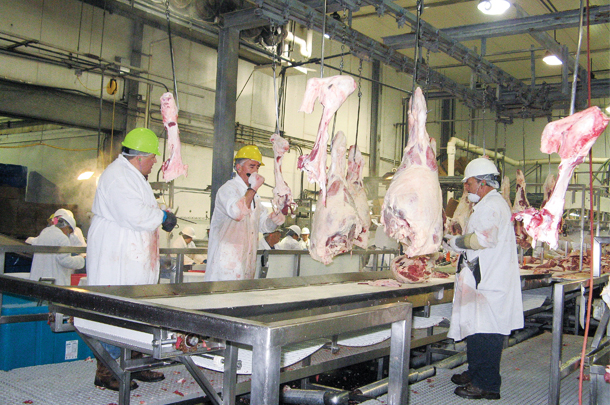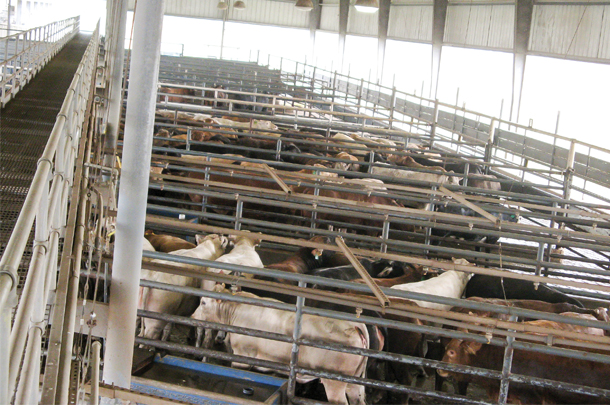Regardless of the effort it takes, every cow-calf operator should tour a beef processing plant to witness the care utilized in providing a clean and safe product. Then you should describe your tour to consumers, especially those who have concerns about beef quality.
Kane Beef tour
The authors had an opportunity to tour the Kane Beef processing plant in Corpus Christi, Texas, under the guidance of Jon Surman, vice president of operations. Kane buys steers and heifers from about 30 feedyards in south Texas and sells to U.S. grocers, domestic food wholesale distributors and to more than a dozen foreign countries.
“Tours begin at the end of the process rather than the beginning to avoid contamination of the clean areas from animals that have not had their hides removed,” explains Surman.
Our first stop is the clothing supply room, where we don white coats that reach below our knees, put booties over our shoes and hairnets on our heads. The last item is a hard hat.
As we enter the cutting floor, Surman draws our attention to the different colors of hard hats worn by the employees. “Trained employees wear white hats, and trainees wear green,” Surman says. “Trainers can be recognized by their brown hats and foremen by yellow. Managers and supervisors wear blue hats.

The significance of the colored hats is important so every employee entering the manufacturing area understands the position of each person. This practice plays a large role in producing a safe, wholesome food product free of contamination that meets our customer’s specifications.”
A conveyer belt snakes through the cutting room where beef enters as half-carcasses and leaves as steaks, roasts and other cuts. Employees stand along the conveyor making their assigned cuts. Each employee makes their cuts with skills of the old-time butcher but with efficiency of a modern-day processing line.
Work is continuous except for a mid-morning break, lunch – and a mid-afternoon break if the shift is extended. Coats, hairnets and booties are changed during breaks if they have become soiled. The meat is boxed and placed in walk-in coolers for chilling and eventual shipment.
“During breaks, cleaners wash the work areas and take swabs for harmful micro-organism (pathogen) testing,” says Surman. “Each carcass is tagged so it can be identified and sourced back to the animal and feedyard from which it came.
If a swab or meat sample tests positive for pathogens, we collect all the beef that could possibly be contaminated, place it in quarantine and collect samples. Meat that tests negative is released into production. Any meat that tests positive is rendered. We work very closely with our local feeders to share quality and food safety information. All parties work together to ensure a safe food product for the consumer.
“We have a medical doctor on our staff with a small clinic,” Surman continues. “Any employee that has a runny nose or other possible illness symptoms is sent to the clinic for diagnosis. The person is then treated or sent home if needed. Our doctor is also equipped to treat minor injuries if they occur.”
Working carcasses
Whole carcasses enter the cutting area minus the head, hide and viscera (organs). The carcasses are halved and graded. A photograph of the ribeye area is taken with a video camera, and the image is transmitted to a computer, which determines the grade verified by a USDA grader.
The camera measures ribeye size, fat thickness around the eye (yield) and internal marbling within the eye and instantly provides a grading score. Carcasses are then moved to a chilling room, sorted by grade and held for further processing.
Between the fabrication and harvest rooms, we throw our white coats into a laundry basket and put on clean gray coats. The gray coats signify we have been in the harvest area and are barred from re-entering the fabrication room.
We are not allowed to go into the grind plant. Only designated employees are allowed in that area to reduce the possibility of contamination.
Heads are skinned after being removed from the carcass. Kane has a good market for heads in south Texas because of the popularity of barbacoa, a type of barbecue made from beef heads. Hides are removed from the animals by a combination of skilled employees with air knives and a machine. After removal, hides are cured and sold to tanneries.
“After the viscera is removed from the animal, each organ is inspected by the USDA inspection staff under the leadership of the veterinarian for any sign of illness or disease,” says Surman. “If the viscera passes inspection, it is washed and sent to the clean room for processing into offal, which includes tripe, sweetbreads, liver and heart.
Employees switch knives between each carcass, leaving the previous knife in a 180-degree sterilizer to prevent cross-contamination between cuts.”
Before animals are bled, they are sprayed with chlorinated water to wash away dirt, manure or any other particles stuck to their hide. Following hide removal, carcasses are sprayed with hot water and, later, lactic acid to remove any pathogens.
Lactic acid is an organic compound and is produced in animals (including humans) during normal metabolism and exercise.
“Cattle at Kane are knocked with a pneumatic stun gun which renders the animals insensible,” Surman says. “An inspector watches the task performed to ensure that only one knock is required.”
Holding pens for live cattle are the last stop on the tour, where we observe heifers and steers standing quietly in the shade of a covered roof, appearing very content. Fresh water is available in every pen.
Live animals
“Cattle are unloaded and moved using low-stress handling techniques,” says Surman. “If cattle are held for more than 24 hours prior to harvest, they are fed. The alley and ramp into the plant were built to Dr. Temple Grandin’s specifications.”

“Every live animal is checked by the USDA inspection service, and it does not enter the processing facility without a signed approval from the USDA,” Surman continues. “All Kane cattle pushers go through an extensive background check and are trained in proper animal handling techniques.”
By touring a beef processing plant at Kane, you are reassured that beef is handled properly and is a safe product to eat. Every day after the Kane day shift is completed, the night crew arrives and completely washes, scrubs and disinfects the entire plant.
In addition to the Kane inspectors, there are 12 on-site USDA inspectors who continually watch the entire operation to ensure the meat is processed in a sanitary manner.
Even though Kane pays for the service, these inspectors are solely supervised by the USDA. They have a separate lunch/break room and do not mix with Kane employees.
JF O’Neill Packing Company
To obtain a broader view of how beef is processed, a telephone interview was conducted with Brian O’Neill, vice president of JF O’Neill Packing Company, Omaha, Nebraska. JF O’Neill does not take title to cattle. Instead, the company custom-processes beef for producers involved in pasture-to-plate programs. It was learned that the processing and sanitation methods utilized at JF O’Neill are very similar to those practiced by Kane.
“We completely wash and disinfect the plant every day,” O’Neill says. “Each carcass is washed with hot water and lactic acid prior to processing. We randomly take fat samples and swabs of equipment for pathogen analysis by a third-party laboratory.
Employees wear coats, booties, hairnets and nets over their mouths for hygiene purposes. The clothing is changed at least once daily. All employees are given hygiene training, and those that work with live animals receive training on low-stress handling techniques. Background checks are performed on the livestock handlers.”
Because the company is smaller than Kane, there are only two USDA full-time inspectors at JF O’Neill. A third USDA inspector periodically appears unannounced and makes spot checks of hygiene practices.
“If a sample tests positive for pathogens, all exposed meat is quarantined in a designated cooler,” O’Neill continues. “Owner of the meat is contacted and given three choices. He can cook the meat, which kills the pathogens, sell it to a rendering plant, where it is cooked, or have it incinerated.”
Due to regimented hygiene practices and constant testing, beef processors in the U.S. provide safe products to the consumer. These products come from animals that are treated with respect and utmost concern for their welfare. These facts need to be delivered to consumers at every opportunity. ![]()
Robert and Janelle Fears are freelance writers based in Texas.
PHOTO 1: Half-carcasses enter on one side of the fabrication room and leave from the other side as steaks and roasts.
PHOTO 2: Color of the hard hats show that a trained employee, a trainee and the foreman are working at the front table.
PHOTO 3: Live cattle, waiting to be processed, are held in shaded pens with plenty of fresh water. Photos by Robert Fears.






